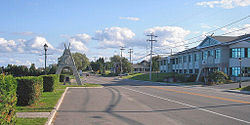Mashteuiatsh, Quebec
| Mashteuiatsh | |
|---|---|
| Indian reserve | |
 |
|
| Coordinates: 48°34′N 72°14′W / 48.567°N 72.233°WCoordinates: 48°34′N 72°14′W / 48.567°N 72.233°W | |
| Country |
|
| Province |
|
| Region | Saguenay–Lac-Saint-Jean |
| RCM | None |
| Formed | September 6, 1856 |
| Government | |
| • Chief | Clifford Moar |
| • Federal riding | Roberval—Lac-Saint-Jean |
| • Prov. riding | Roberval |
| Area | |
| • Total | 15.20 km2 (5.87 sq mi) |
| • Land | 14.50 km2 (5.60 sq mi) |
| Population (2011) | |
| • Total | 2,213 |
| • Density | 152.6/km2 (395/sq mi) |
| • Change (2006–11) |
|
| • Dwellings | 1,005 |
| Time zone | EST (UTC−5) |
| • Summer (DST) | EDT (UTC−4) |
| Postal Code | G0W 2H0 |
| Area code(s) | 418 and 581 |
| Website | www |
Mashteuiatsh is a First Nations reserve in the Saguenay–Lac-Saint-Jean region of Quebec, Canada, about 6 kilometres (3.7 mi) north from the centre of Roberval. It is located on a headland jutting out on the western shores of Lake Saint-Jean known as Pointe-Bleue, in the geographic township of Ouiatchouan, and belongs to the Montagnais du Lac St-Jean Innu band. It is geographically within the Le Domaine-du-Roy Regional County Municipality but administratively not part of it.
Previously officially known as Ouiatchouan Reserve, it was renamed Mashteuiatsh in 1985, from Ka Mesta8iats, meaning "where there is a point" or "seeing one yet again at the point".
Mashteuiatsh is serviced by a health centre, community radio station, arena, library, community and sports centre, social services centre, municipal water and sewer system, fire station, and an aboriginal police force. The reserve is home to the Mashteuiatsh Amerindian Museum (Musée amérindien de Mashteuiatsh), which was founded in 1977 with a mission to preserve Innu cultural heritage.
Before Europeans arrived in the area, the site was a frequently used stopover place and camp of the indigenous Innu. Circa 1775, a trading post was established there, owned by English merchants Thomas Dunn and John Gray.
In 1853, the Commissioner of Crown Lands, John Rolph, had proposed to assign the Innu living near the Peribonka River, north of Lake Saint-Jean, a reserve of 16,000 acres (6,500 ha) and the Innu residing in Métabetchouan Township, south of Lake Saint-Jean, were allotted 4,000 acres (1,600 ha). But because Pointe-Bleue had been their traditional site and because loggers would not respect the boundaries of the reserved lands, the Innu asked the Government of Canada to exchange these lands bordering the Peribonka and Métabetchouane Rivers for those in Ouiatchouan Township where Pointe-Bleue is. This request was granted in 1856, and the Innu were allotted an area of 23,040 acres (9,320 ha), from then on officially known as Ouiatchouan Reserve.
...
Wikipedia

